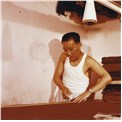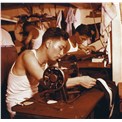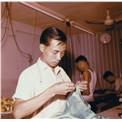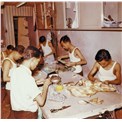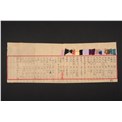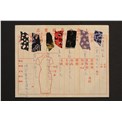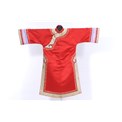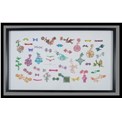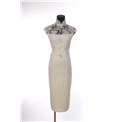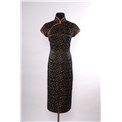-
History & Society
- Education in Pre-war Hong Kong
- History of Taikoo Sugar Refinery
- Hong Kong Products Exhibition
- Local Festivals Around the Year
- Post-war Industries
- Pre-war Industry
- The Hong Kong Jockey Club Archives
- Tin Hau Festival
- Memories We Share: Hong Kong in the 1960s and 1970s
- History in Miniature: The 150th Anniversary of Stamp Issuance in Hong Kong
- A Partnership with the People: KAAA and Post-war Agricultural Hong Kong
- The Oral Legacies (I) - Intangible Cultural Heritage of Hong Kong
- Hong Kong Currency
- Hong Kong, Benevolent City: Tung Wah and the Growth of Chinese Communities
- The Oral Legacies Series II: the Representative List of the Intangible Cultural Heritage of Hong Kong
- Braving the Storm: Hong Kong under Japanese Occupation
- A Century of Fashion: Hong Kong Cheongsam Story
Geography & EnvironmentArt & Culture- Calendar Posters of Kwan Wai-nung
- Festival of Hong Kong
- Ho Sau: Poetic Photography of Daily Life
- Hong Kong Cemetery
- Sketches by Kong Kai-ming
- The Culture of Bamboo Scaffolding
- The Legend of Silk and Wood: A Hong Kong Qin Story
- Journeys of Leung Ping Kwan
- From Soya Bean Milk To Pu'er Tea
- Applauding Hong Kong Pop Legend: Roman Tam
- 他 FASHION 傳奇 EDDIE LAU 她 IMAGE 百變 劉培基
- A Eulogy of Hong Kong Landscape in Painting: The Art of Huang Bore
- Imprint of the Heart: Artistic Journey of Huang Xinbo
- Porcelain and Painting
- A Voice for the Ages, a Master of his Art – A Tribute to Lam Kar Sing
- Memories of Renowned Lyricist: Richard Lam Chun Keung's Manuscripts
- Seal Carving in Lingnan
- Literary Giant - Jin Yong and Louis Cha
Communication & Media- Hong Kong Historical Postcards
- Shaw Brothers’ Movies
- Transcending Space and Time – Early Cinematic Experience of Hong Kong
- Remembrance of the Avant-Garde: Archival Camera Collection
- Down Memory Lane: Movie Theatres of the Olden Days
- 90 Years of Public Service Broadcasting in Hong Kong
- Multifarious Arrays of Weaponry in Hong Kong Cinema
-
History & SocietyGeography & EnvironmentArt & Culture
-
View Oral History RecordsFeatured StoriesAbout Hong Kong Voices
-
Hong Kong Memory
- Collection
- All Items
- The Cheongsam Tailors of Hong Kong
Recently VisitedThe Cheongsam Tailors of Hong Kong
A Hong Kong tailor uses a triangular tailor's chalk to cast patterns directly onto a piece of fabric, early 1960s. Hong Kong tailors take turns to use the sewing machine at a workshop, early 1960s. The dexterous hands of a Hong Kong tailor at work sewing clothes, early 1960s. A cutting bed at a tailor's workshop positioned to allow tailors to work on all four sides at the same time, early 1960s. Tailor's invoice
1950s
Hong Kong Museum of History collection
Before making cheongsams for a patron, a tailor would list the type, style and number of dresses on an invoice. As the fabrics were provided by the patron, the tailor would cut out and attach swatches to the itemised list to avoid making mistakes and to make it easier to verify later that the fabric was correct.Measurement sheet and invoice from Shanghai Hung Cheong Tailor's Shop
Circa 1980s
Hong Kong Museum of History collection
The address printed on this measurement sheet and invoice is located at Yue Fai Court, a residential building in Aberdeen on Hong Kong Island, suggesting that the tailor shop was in fact a home workshop. Starting in the 1970s, large numbers of cheongsam tailor shops closed down in Hong Kong, and the tailors then set up their own workshops at home. Lined cheongsam for demonstration purpose
2000s
Hong Kong Museum of History collection
This cheongsam was designed as a long robe of the Qing Manchu women. The straight wide body, broad sleeves, collar, flap, cuffs and sweep adorned with decorated borders are all characteristics of the traditional cheongsam. Made by Master Shang Rongtang, this cheongsam was intended for demonstration purpose at the Shanghai Tailoring Workers General Union in order for tailors to preserve and pass on their skills. Flower buttons
2013
Hong Kong Museum of History collection
This set of exquisite flower buttons was made by Po Ming Wah, who has been producing traditional flower buttons for four decades and is one of the very few surviving experts in this craft in Hong Kong.
Flower buttons come in a hundred or more designs and styles and feature rich and exciting colour schemes. They are characterised by a rich repertoire of shapes and themes, including traditional auspicious patterns as well as flowers, birds, fish and insects. Flower buttons produced using traditional skills passed down by Shanghai craftsmen are regarded as more exquisite than their Guangdong counterparts. One of the characteristics of the Shanghai-style flower buttons is the 'stuffed loop'. Cotton wool is often stuffed into the loops to give more depth and solidity and thus a more opulent look.
Straight knotted buttons are largely used in traditional Chinese attire. The end of one braid is worked into a ball-like knot while the end of another is made into a loop. They are then stitched to either side of the front opening of the cheongsam. Cheongsam tailors usually only make knot-shaped buttons themselves; production of more complicated buttons is outsourced to specialist flower button makers. Flower buttons come in pairs and are identified as male (the knot) and female (the loop). Pairs where the male and female are an identical size are intended for the collar and the centre front opening. Those used on the lapel on the right side of the cheongsam usually comprise a larger male and a smaller female stitched on the upper and under-flap respectively, complementing each other to form a complete pattern. These two cheongsams, made by one of the Hong Kong's only remaining cheongsam tailor of the Shanghai school, Tong Kai Cheung, demonstrate how remarkably the school's tailoring techniques have been perpetuated in Hong Kong. One of the cheongsams features a fashionable design, while the other was made in the classic style. The former opens new creative paths for Hong Kong cheongsam designs, whereas the latter represents its classic charm during its heyday. The tailor's exquisite craftsmanship, meticulous professionalism and pursuit of artistic perfection are epitomised in these two – traditional and innovative – cheongsams.
Lined cap-sleeved ivory cheongsam with see-through lace top
2013
Hong Kong Museum of History collection
This dress fuses traditional cheongsam elements with the fabric and design of Western ceremonial attire. It has a round high, straight collar, a back opening, darts at the chest, and front and back of the waist, and slits. Made with ivory wool and silk-blend twill from Italy, the cheongsam features a low-cut, backless design, and is covered with French sequined see-through lace of the same colour. The lace, which extends to the lower abdomen, has a wavy border at the bottom, and the cheongsam is lined with silk of the same colour. Since the lace is extremely thin and porous, a thin layer of gauze is added to the underside to strengthen the fabric.
In order to accommodate the 'back opening' design, three sets of fancy buttons – buttons and loops made with fabric tubes – are sewn into the back of the high collar. See-through plastic instead of the usual hard, opaque material is used as the lining of the high collar for the perfect result. These two cheongsams, made by one of the Hong Kong's only remaining cheongsam tailor of the Shanghai school, Tong Kai Cheung, demonstrate how remarkably the school's tailoring techniques have been perpetuated in Hong Kong. One of the cheongsams features a fashionable design, while the other was made in the classic style. The former opens new creative paths for Hong Kong cheongsam designs, whereas the latter represents its classic charm during its heyday. The tailor's exquisite craftsmanship, meticulous professionalism and pursuit of artistic perfection are epitomised in these two – traditional and innovative – cheongsams.
Lined 'short crossed-sleeve' brocade cheongsam with embroidered floral scrolls on black ground
2013
Hong Kong Museum of History collection
This cheongsam, a classic Hong Kong design in the 1950s, was made with conventional Chinese fabric, using traditional techniques of the Shanghai school. It has a round high, straight collar, a large round front-flap, darts at the chest, and the front and back of the waist, and slits.
The dress was made with elegant machine-embroidered fabric, featuring colourful floral patterns, and lined with black creased satin. The collar, front-flap, cuffs, hem and side slits are adorned with double satin borders to highlight the lines of the cheongsam and accentuate the design, especially at the collar and front-flap. No trace of stitches can be seen on the surface of the gown – an exemplification of exquisite craftsmanship. The smooth-running lines from the waist to the slit on either side are the result of sophisticated guibo ironing skills.Copyright © 2012 Hong Kong Memory. All rights reserved.
| Set Name |






